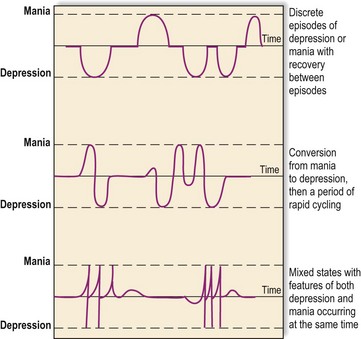Epidemiology and aetiology of mood disorders
Bipolar affective disorder
Aetiology
There is a raised rate of adverse life events prior to manic episodes, although social factors appear to play less of a part in precipitating mania once several episodes have occurred. Disruption of biological rhythms, for example as a result of travelling across time zones, can sometimes precipitate mania and many people with bipolar disorder find that the frequency of manic relapse can be reduced if they maintain a regular sleep pattern. There is a raised rate of manic episodes in spring and early summer. Childbirth is a common precipitant of affective episodes in women with bipolar disorder (see ‘Puerperal psychosis’ section on p. 78).
Course of illness
Manic episodes typically last between 4 and 6 months, although this can vary considerably. Once someone has experienced a manic episode, it is likely that they will go on to have further affective episodes. The frequency and nature of these episodes varies greatly between individuals and some examples of relapse patterns in bipolar disorder are shown in Figure 1. The duration of remission between episodes tends to decrease over time. Clustering of episodes also occurs, with several episodes of mania and depression occurring close together, followed by a relatively long period of full recovery. ‘Rapid cycling’ can be viewed as an extreme form of clustering.
< div class='tao-gold-member'>
Stay updated, free articles. Join our Telegram channel

Full access? Get Clinical Tree




